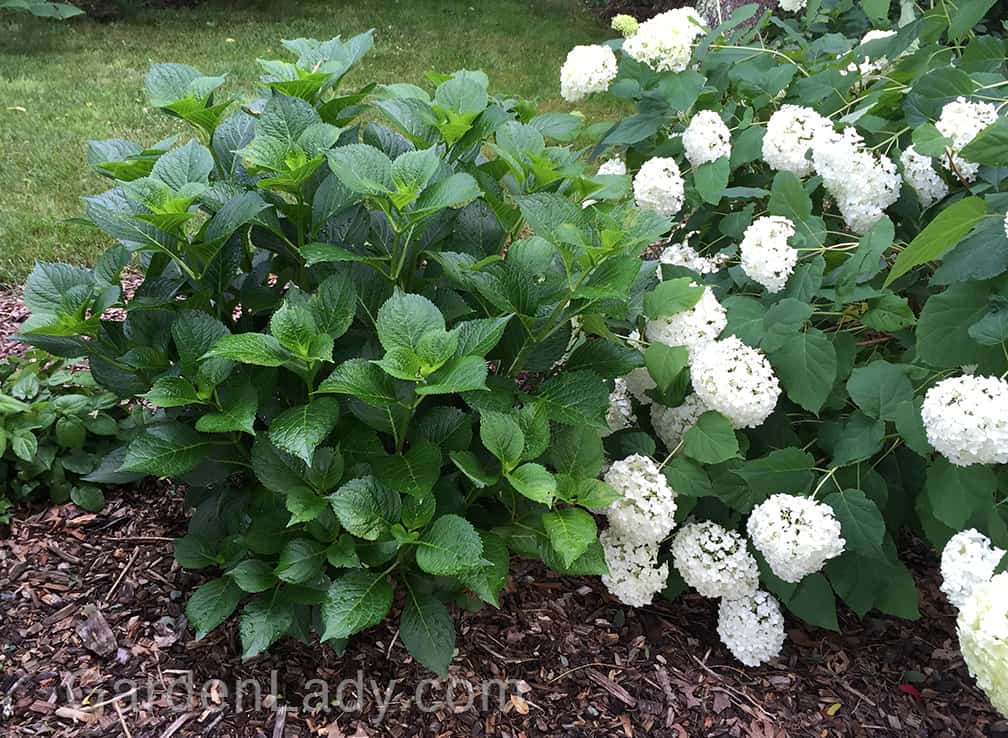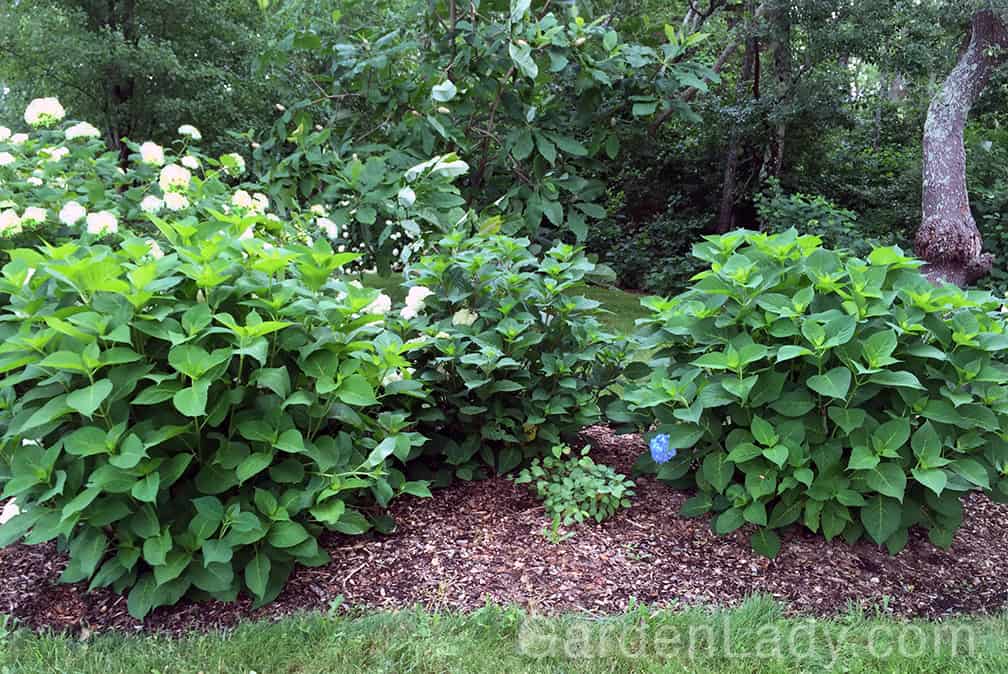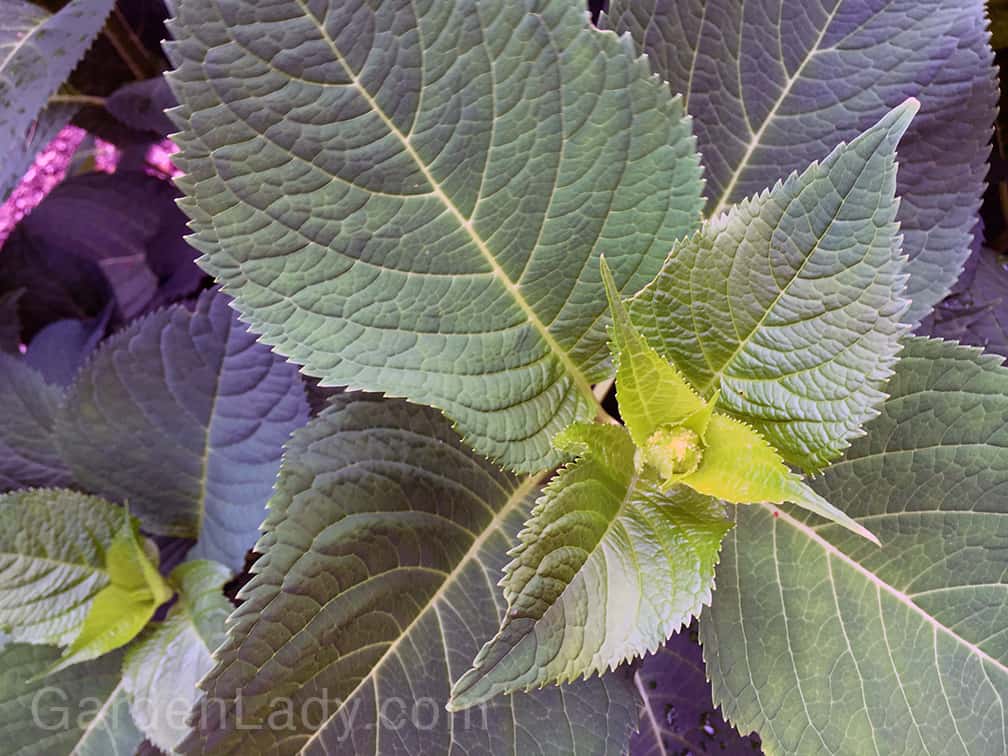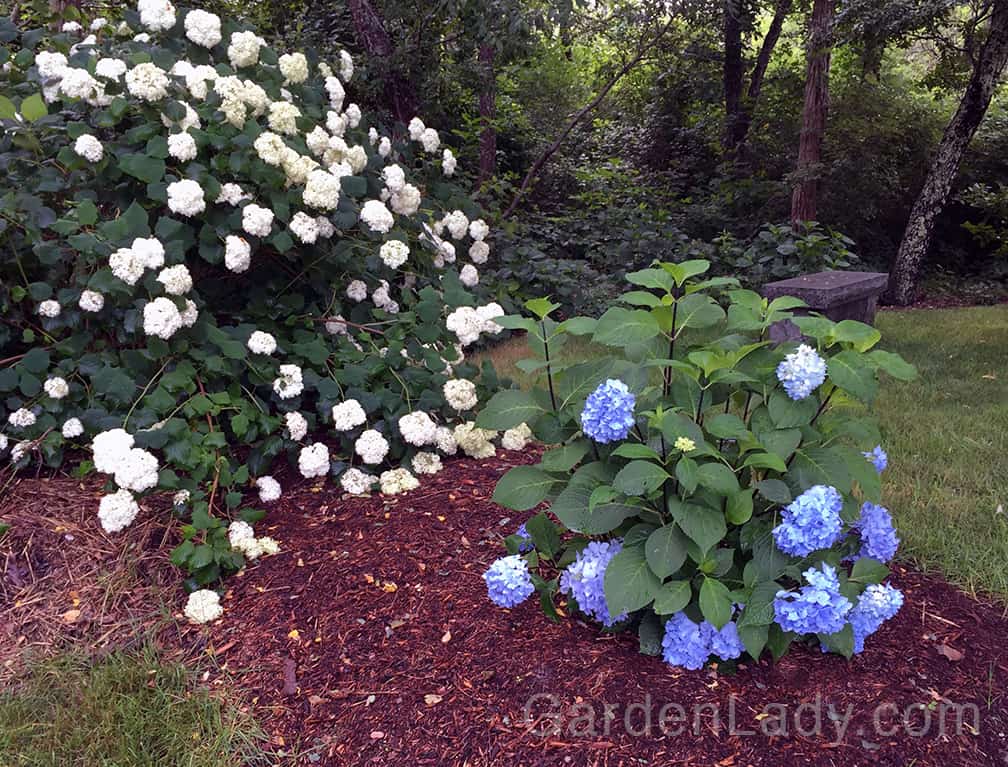This is the most frequent question I’m asked on my radio programs, and lately I’ve been getting several emails a day as well. We love the blue mophead and lacecap hydrangeas, so it’s upsetting when there are no blooms! Here is what’s going on.
First of all, it’s important to know that these plants produce their flowers on old wood. What is old wood? This just means that in the late summer the plants form flower buds on the canes that will bloom the following year. You can’t see them, but the germ of next year’s flowering is already on the canes in the fall. This is the reason that it’s important not to cut Hydrangea canes back in the autumn (remember: Don’t Fall Down!) or in the spring. For pruning information, see this article.
In addition to inappropriate pruning, the main cause of these Hydrangeas not blooming is cold winter or early spring temperatures. If the temperatures drop into the single digits for very long, those flower buds get zapped. If the buds are swelling in the early spring, and the temperature drops into the 20’s, they are also killed. And if the temperatures go below zero fahrenheit at any time, your mophead and lacecap hydrangeas won’t flower the following year.
The winter of 2015 and 2016 was a “hydrangea flower killing winter” because of two things. First of all, it was mild, mild, mild for a long time. My husband and I walked on the beach in short sleeved shirts on Christmas day! But then, after such warm weather it suddenly dropped below zero over one weekend in February. That killed off many hydrangea flower buds. And many that made it through that period got zapped later in the spring. We had a very warm March in the Northeast, and many hydrangea buds started to swell and break dormancy. Then the second week in April the temperatures dropped into the 20’s, killing off any remaining flower buds.
Some people who are in warmer locations (closer to the ocean) or have their plants in a warmer micro-climate in sheltered spots, still have fair to good flowering. But many have no flowers at all.
If your Hydrangeas are the type that also flower on new growth (Endless Summer, Penny Mac, All Summer Beauty, BloomStruck etc) you’ll have some flowers later in the summer or early fall. And those Hydrangea species that bloom on new growth – H. paniculata varieties such as LimeLight, and H. arborescens types such as Annabelle – will flower as always.
What can you do for next year? Remove all dead canes. The ideal time to do this is in late May (see pruning sheet) but it can be done any time. Next, don’t cut your shrubs back this fall. Keep them deeply watered less often (usually every 5 to 7 days – water with a sprinkler, not by hand) and give them an application of an organic fertilizer in the spring. Note that wrapping doesn’t usually help unless you can erect a wind-barrier in exposed locations. The hydrangeas that I carefully wrapped with burlap and piled salt-marsh hay over the canes didn’t do any better than those that had no protection at all.
Finally, pray for a mild winter!

Many people have Hydrangeas that look like the one on the left in this photo: no flowers at all. This is a Glowing Embers and it has always been pretty fragile when it comes to cold temperatures. Next to it is the white-flowering Annabelle, which blooms on new wood, so it’s dependable. Too bad they haven’t bred a blue-flowering Annablelle. (Note that there is a pink one…see the Invincibelle Spirit II post earlier this month)

Some people have a few flowers around the bottom part of the plant. This is because the flower buds close to the ground made it through the winter, either because they were less exposed to the wind or were protected by snow or leaves. Here is an Endless summer on the left, a Twist n’ Shout in the center, and a Penny Mac on the right. All should have a few flowers on new growth later in the season.

Here is a flower forming on one of the new canes on Penny Mac. It should be opening in August. Yay!

I was really impressed with how Enchantress did given the winter conditions. (Sometimes labeled as Blue Enchantress) It also had dead canes when I went out to prune it in May, but look at how many flowers it has now! Some of these might be coming from very low buds that made it, but some of them are definitely on new growth. This plant was given to me by the folks at Monrovia last summer, and it’s a variety that’s clearly an up-and-commer…good bloom after a hard winter and black stems as well!

Thanks again for all your info! Always helpful!
Thanks for that information. Sad they didn’t bloom, but happy to know it wasn’t my fault!
This has happened to so many folks. It’s good to know why we have no flowers this year, and also, how to care for them so they will bloom next year. Thanks!
Love getting this information. Now I know why my big blue hydrangea has only 2 flowers.
Thank you for the detailed information- I had no idea as to why there weren’t any blooms yet!
I am a newcomer to your post and just at the right time too! My hydrangeas have not bloomed this year either. Only the one in the pot and my beautiful young hydrangea tree.
Pamela – if you are in one the places where it got below zero, that’s why. Your hydrangea tree will always flower because it’s a different species – Hydrangea paniculata – and these flower on new growth not last year’s. So thankfully, they always flower no matter how cold it was in the winter.
I have hydrangea bushes that always had many large blooms deep pink in color…at least until about four years ago. Then no blooms. Out of six bushes one bloom. We live in south Niagara Ontario. Have tried ferilizer, less water, more water, not cutting till late May. I was also treating to make the blooms a slight purple hue. Could this have caused it? It’s such a disappointment. They bloomed most of summer to mid fall.
Frances – My guess is that the winter temperatures in the past four years have first been warm, then plunged into single digits or below. This freezes the the buds on blue hydrangeas that were formed in August. If the buds dried out in August/Sept etc (less water) that might also be an issue but for most people it’s the fact that buds form and swell early because falls and early winter are extra mild and then in Jan or Feb there are sudden cold snaps. BtW – if you cut your hydrangeas down you’ll be cutting off the flowers for the summer, no matter when you do it. Read about pruning these hydrangeas here: https://gardenlady.com/read-articles/how-to-prune-hydrangeas/
Thank You! thank You!! So good to know.
Kim, Thanks for letting me know! I’m glad the post was helpful for you.
I have three endless summer plants. They are 5 years old. All get the same sun, water, and weather exposure. One is pink and the other 2 are blue. The pink one is thriving and has numerous buds ready to pop into bloom. However, my other 2 blue plants I have one blossom ready to bloom. One of the plants has not flowered except the year I planted it! I’ve been very careful about pruning. I’ve also fertilized with Holly-Tone, But nothing on the blue Hydrangeas! The plants are beautiful green and lush with very little browning.
Why does my blue ones not flower? I’m frustrated! I bought these endless summer because they were suggested the best for my area Zone 6, Central PA. What am I doing wrong?
Cheryl,
If any H.macrophylla (the genus and species of Endless Summer and most other blue “mopheads”) isn’t flowering, it’s most likely because something is happening to the buds that they produce in August which will form the flowers the following year. The buds that form at the leaf nodes (where the leaves attach to the stems) are the germ of next year’s flowers, so if they get cut off, dried out, or zapped by cold temps or cold winds, that will prevent them from flowering. So think about these possibilities:
1. If winter temps go below 10F. for any length of time, that can kill the buds.
2. If the fall is very warm (Hello, Climate Change!) these buds can start to break dormancy as if it’s spring, but they get zapped once winter hits.
3. Trimming down, at any time. The only pruning that should be done to these plants is to look at them in late-spring and see what canes have small green leaves on them and which ones don’t. Cut out all canes or tips of canes that don’t have green leaves, and leave all the rest.
4. Drought in the fall. Since flower buds are formed in August, if it’s very dry after that, the buds might die.
Why would one shrub have flowers and not another? The plant that isn’t flowering: is in more shade (they need at least 3 hours of direct sun to flower) Is in more cold wind. Is in an exposed location in the spring where cold winds sweep through. Is in dryer soil. Is a colder microclimate. Is in soil that isn’t in balance in regard to nutrients. (Have a complete soil test done – never assume.)
I hope this helps!